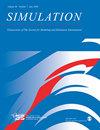Knowledge-based and data-driven behavioral modeling techniques in engagement simulation
IF 2
4区 工程技术
Q4 COMPUTER SCIENCE, INTERDISCIPLINARY APPLICATIONS
Simulation-Transactions of the Society for Modeling and Simulation International
Pub Date : 2023-06-12
DOI:10.1177/00375497231177123
引用次数: 0
Abstract
As knowledge and data increase in scale and complexity, it is more difficult to apply these two key assets to achieve optimal effectiveness in engagement simulation. The aim of this study was to investigate the techniques of knowledge and data integration with respect to the development of smart agents to predict accurate behaviors in tactical engagements. To reduce the complexity of combat behavior representation, with respect to the functions, we represented subject matter expert operational knowledge by proposing multiple levels of cascaded hierarchical structure, namely, the function decision tree, to increase the readability and maintainability of the behavioral model. For decision points in a behavioral model, smart agents can be trained based on data samples collected from rounds of constructive simulations which provide validated physical models and tactical principles. As a proof of concept, we constructed a simulation testbed of multi-warhead ballistic missile penetration, which generated 129,600 constructive simulations over a total of 84 h. Thereafter, we selected 5817 data samples (i.e. ~4.5% of the simulations) using an operational metric of total rewards exceeding 100. The data samples are used to train an artificial neural network and then this network is used to develop a deep reinforcement learning agent. The results revealed that the training process iterated nearly 17,000 epochs until the policy loss decreased to an acceptable low value. The smart agent increased the ratio of ballistic missile target hits by 18.96%, a significant increase when compared with the traditional rule-based behavioral model.交战模拟中基于知识和数据驱动的行为建模技术
随着知识和数据规模和复杂性的增加,应用这两种关键资产来实现交战模拟的最佳效果变得更加困难。本研究的目的是研究与智能代理开发相关的知识和数据集成技术,以预测战术交战中的准确行为。为了降低作战行为表示的复杂性,在功能方面,我们提出了多层级联的层次结构,即功能决策树来表示主题专家作战知识,以提高行为模型的可读性和可维护性。对于行为模型中的决策点,智能代理可以根据从几轮建设性模拟中收集的数据样本进行训练,这些模拟提供了经过验证的物理模型和战术原则。作为概念验证,我们构建了一个多弹头弹道导弹突防仿真试验台,在84小时内生成了129,600个建设性模拟。此后,我们选择了5817个数据样本(约占模拟的4.5%),使用总奖励超过100的操作指标。这些数据样本被用来训练一个人工神经网络,然后这个网络被用来开发一个深度强化学习代理。结果表明,训练过程迭代了近17,000次,直到策略损失降低到可接受的低值。该智能代理将弹道导弹目标命中率提高了18.96%,与传统的基于规则的行为模型相比有了显著提高。
本文章由计算机程序翻译,如有差异,请以英文原文为准。
求助全文
约1分钟内获得全文
求助全文
来源期刊
CiteScore
3.50
自引率
31.20%
发文量
60
审稿时长
3 months
期刊介绍:
SIMULATION is a peer-reviewed journal, which covers subjects including the modelling and simulation of: computer networking and communications, high performance computers, real-time systems, mobile and intelligent agents, simulation software, and language design, system engineering and design, aerospace, traffic systems, microelectronics, robotics, mechatronics, and air traffic and chemistry, physics, biology, medicine, biomedicine, sociology, and cognition.

 求助内容:
求助内容: 应助结果提醒方式:
应助结果提醒方式:


